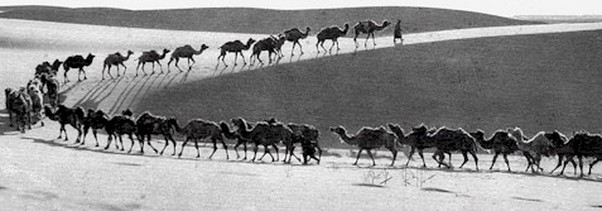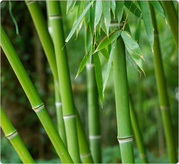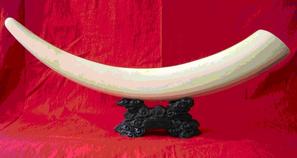The Silk Road - by Alec Briggs
The Silk Road is a web of trading routes linking Eastern Asia to the Middle East. The route starts at Chang’an in central China, and works its way west, eventually ending in Antioch, Jerusalem, or New Saray depending on the actual paths followed.
Geography
The Silk Road runs through some of the harshest environments on Earth. A portion of the path runs through the Taklimakan desert. This desert consistently reaches over 100° Fahrenheit, and temperatures of over 120° are not uncommon. In the winter the temperature can easily drop into the negatives. One of the major dangers of this desert is the lack of water. The Gobi desert lies to the northeast and is slightly easier to navigate because there are frequent oases. The Taklimakan is very scarcely supplied with water.
Surrounding this desert are more geographical obstacles that can be very difficult to surpass. The Gobi in the northeast, although better supplied with water, has almost as harsh of a climate. Then there are the Himalaya, Karakorum and Kunlun mountains. The only ways through these mountains are a few passes that can be extremely difficult to traverse. Most are over 5,000 feet in elevation and are all icy and precarious. The Tamir and Tianshan mountains border the north and west of the desert. Although smaller and less harsh than the ranges to the south, these mountains still cause troubles for travellers. The rest of the road runs through the dry climate of the Middle East until it reaches a more comfortable climate in Mesopotamia.
History
The name of the Silk Road was coined by Marco Polo, a Venetian merchant who is thought to be the first European to reach China. Silk was chosen as the defining factor of these routes because it was considered the most precious of the goods that were traded. The road was first established by Zhang Qian, who was a civilian of the Han dynasty in China. He was sent to negotiate a peace treaty with a neighboring tribe to the west of China, the Xiongnu, in 138 B.C. He travelled on the path that would eventually become The Silk Road. Although his peace negotiations failed, he opened up trade by stirring interest in silk in Central and Western Asia. Trade opened up along the path, going steady until the collapse of the Han dynasty around 220 A.D., after which it slowly diminished.
The routes opened up again with the establishment of the Tang dynasty. This era is also marked with the adoption of Buddhism in China. This religion, which plays a very important role in Chinese history, was brought to China by The Silk Road. Other religions, such as Islam, Zoroastrianism, and Nestorianism, were also spread throughout Asia by the road. Other cultural identities, such as dance, art, and music were mixed throughout Asia over the road. The Tang dynasty was a high point in The Silk Road because they were more open to outside cultures than previous Chinese dynasties had been. Once again, Trade on The Silk Road died with the collapse of the Tang dynasty in 907 A.D.
The routes were revived again by the rise of the Mongol Empire. They created the largest continuous empire ever, and this empire included most of the territory of The Silk Road. This unity amongst the route created a large flow of merchants and missionaries between Asia and Europe. The collapse of the Mongol empire coincided with the discovery of a sea route to Asia in the late fifteenth century, which created a sharp decline in the use of The Silk Road. Towns, oases, and the nomadic empires along this route sank into poverty. They also failed to match the technological advances of neighboring civilizations such as guns and cannons. This put an end to The Silk Road, except for a small revival in the late nineteenth century. This revival came from an interest in colonizing Asia.
The Silk Road runs through some of the harshest environments on Earth. A portion of the path runs through the Taklimakan desert. This desert consistently reaches over 100° Fahrenheit, and temperatures of over 120° are not uncommon. In the winter the temperature can easily drop into the negatives. One of the major dangers of this desert is the lack of water. The Gobi desert lies to the northeast and is slightly easier to navigate because there are frequent oases. The Taklimakan is very scarcely supplied with water.
Surrounding this desert are more geographical obstacles that can be very difficult to surpass. The Gobi in the northeast, although better supplied with water, has almost as harsh of a climate. Then there are the Himalaya, Karakorum and Kunlun mountains. The only ways through these mountains are a few passes that can be extremely difficult to traverse. Most are over 5,000 feet in elevation and are all icy and precarious. The Tamir and Tianshan mountains border the north and west of the desert. Although smaller and less harsh than the ranges to the south, these mountains still cause troubles for travellers. The rest of the road runs through the dry climate of the Middle East until it reaches a more comfortable climate in Mesopotamia.
History
The name of the Silk Road was coined by Marco Polo, a Venetian merchant who is thought to be the first European to reach China. Silk was chosen as the defining factor of these routes because it was considered the most precious of the goods that were traded. The road was first established by Zhang Qian, who was a civilian of the Han dynasty in China. He was sent to negotiate a peace treaty with a neighboring tribe to the west of China, the Xiongnu, in 138 B.C. He travelled on the path that would eventually become The Silk Road. Although his peace negotiations failed, he opened up trade by stirring interest in silk in Central and Western Asia. Trade opened up along the path, going steady until the collapse of the Han dynasty around 220 A.D., after which it slowly diminished.
The routes opened up again with the establishment of the Tang dynasty. This era is also marked with the adoption of Buddhism in China. This religion, which plays a very important role in Chinese history, was brought to China by The Silk Road. Other religions, such as Islam, Zoroastrianism, and Nestorianism, were also spread throughout Asia by the road. Other cultural identities, such as dance, art, and music were mixed throughout Asia over the road. The Tang dynasty was a high point in The Silk Road because they were more open to outside cultures than previous Chinese dynasties had been. Once again, Trade on The Silk Road died with the collapse of the Tang dynasty in 907 A.D.
The routes were revived again by the rise of the Mongol Empire. They created the largest continuous empire ever, and this empire included most of the territory of The Silk Road. This unity amongst the route created a large flow of merchants and missionaries between Asia and Europe. The collapse of the Mongol empire coincided with the discovery of a sea route to Asia in the late fifteenth century, which created a sharp decline in the use of The Silk Road. Towns, oases, and the nomadic empires along this route sank into poverty. They also failed to match the technological advances of neighboring civilizations such as guns and cannons. This put an end to The Silk Road, except for a small revival in the late nineteenth century. This revival came from an interest in colonizing Asia.
Chinese Goods Traded West
· Silk
· Bronze, gold, iron, platinum
· Bamboo
· Ceramics and lacquers
· Furs
· Medicinal herbs and drugs
· Gunpowder
· Papermaking and printing
· Farming/smelting technology
· Silk
· Bronze, gold, iron, platinum
· Bamboo
· Ceramics and lacquers
· Furs
· Medicinal herbs and drugs
· Gunpowder
· Papermaking and printing
· Farming/smelting technology
Western Goods Traded to China
· Perfume
· Ivory and jewels
· Glassware
· Wine
· Spices
· Lions, peacocks, elephants, camels and horses
· Alfalfa
· Grapes, pomegranate, cucumbers, carrots
· Walnuts and sesame
· Perfume
· Ivory and jewels
· Glassware
· Wine
· Spices
· Lions, peacocks, elephants, camels and horses
· Alfalfa
· Grapes, pomegranate, cucumbers, carrots
· Walnuts and sesame
Sources
Konkolewski, Nancy. "Introduction to The Silk Road." Cerritos. N.p., n.d. Web. 27 Sep 2011.
Rossabi, Morris. "The Silk Roads." The Silk Roads. N.p., n.d. Web. 27 Sep 2011.
"Stream of life. The Silk Road History."Sairam Tourism. Sairam Tourism, 19 Aug 2010. Web. 27 Sep 2011.
Wild, Oliver. "The Silk Road." The Silk Road. N.p., n.d. Web. 27 Sep 2011.
Rossabi, Morris. "The Silk Roads." The Silk Roads. N.p., n.d. Web. 27 Sep 2011.
"Stream of life. The Silk Road History."Sairam Tourism. Sairam Tourism, 19 Aug 2010. Web. 27 Sep 2011.
Wild, Oliver. "The Silk Road." The Silk Road. N.p., n.d. Web. 27 Sep 2011.



